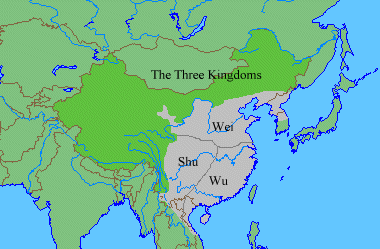Map and Geography

Clicks on me to examine in detail
The end of the Han Dynasty was followed by a long period of disunity and civil war. It began with the Three Kingdoms. These kingdoms grew out of the three chief economic areas of the Han Dynasty. The leaders of the kingdoms strove to reunite the empire and were therefore at constant warfare. These three kingdoms were the Wei, in northern China, the Shu to the west, and the Wu in the east. The Three Kingdoms existed from 220-265 A.D. Buddhism began to spread throughout China during this period. It was introduced in the first century A.D. but did not really begin to spread until after the Han empire collapsed. Tea, although not as popular as it would be in later times, was discovered in the south during this period. Porcelain was also developed during this time.
The kingdom of Wei was ruled by Ts'ao Ts'ao. This was the strongest of the kingdoms, and he had power over the valley of Wei even during the time of the Han rule. Ts'ao Ts'ao attempted to unify all of China under his rule, but was defeated by Sun Ch'ščan and Liu Pei in the battle of the Red Cliff. This defeat was the beginning of the division into three kingdoms. The Wei and Shu kingdoms were both centralized, legalist kingdoms, while the Wu kingdom was ruled by a confederation of the most powerful families of the area. The Wei kingdom eventually captured the Shu kingdom in 263 A.D.
Ts'ao Ts'ao instituted many military changes that would have a great impact on the future of China. His army consisted of both Chinese and people that were considered barbarians, the Hsiung-nu, the Hsien-pei, Wu-huan and the Ch'iang. The members of his army who provided the best troops were the former nomadic herdsmen of the steppes. They were the most skilled mounted bowmen. The use of people from different groups resulted in an assimilation among the people which had not occurred in the past. In the future, these assimilated nomads would form independent kingdoms in North China. The Ssu-ma was a militant family that rose to power very quickly, and one of its members, Ssu-ma Yen founded the new Chin Dynasty in 265 A.D.